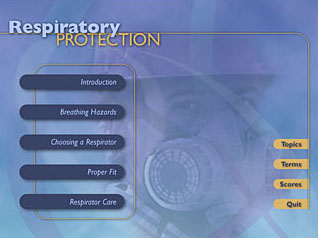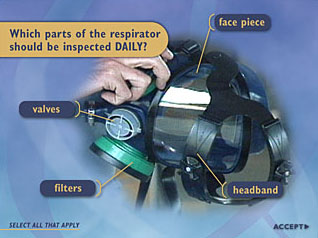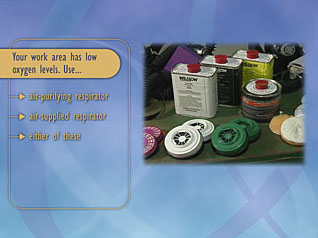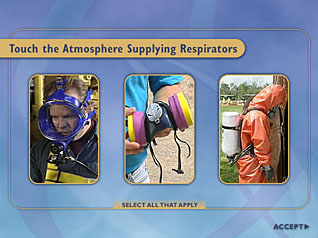Respiratory Protection

- Product ID
- clresmpg_htm
- Training Time ?
- 34 to 68 minutes
- Language(s)
- English
- Video Format
- Standard Definition
- Required Plugins
- None
- Number of Lessons
- 11
- Quiz Questions
- 22



No browser plug-in required to play this version.
Air is one of the most basic elements of our world, and as humans, we need the oxygen provided by air to breathe. But sometimes employees have to work in areas with atmospheres that aren’t safe. This might be caused by lack of oxygen or because the air is contaminated by dusts, mists, vapors, or fumes.
Breathing in contaminated or low-oxygen atmospheres can cause serious illnesses, injuries, and even death. In those situations, special equipment is needed to help employees breathe and stay safe.
Respiratory protection equipment allows employees to protect their lungs against workplace hazards. Because many potentially dangerous places can exist at your place of work, it’s important to make sure that all employees understand the risks of oxygen deficiency and air contamination, have proper respiratory protection equipment, and most importantly, take personal responsibility for their respiratory safety.
By understanding the hazards, selecting the proper respiratory protection, and training employees in their use, you can keep everyone safe and avoid costly injuries and illnesses.

- Install on any SCORM LMS
- Rich multimedia presentation with interactions and quiz
- Print certificate and wallet card
- You have 30 days to complete the course
Training for all workers who are exposed to workplace respiratory hazards and should use respiratory protection equipment.
-
Breathing Hazards
- Respiratory hazards
- Contaminated atmospheres
- Respiratory protection standards
-
Choosing A Respirator
- Air-purifying respirators
- Atmosphere-supplying respirators
- Testing and approval
- Respirator condition
-
Proper Fit
- Inspection
- Putting on the respirator
- Positive pressure seal check
- Negative pressure seal check
- Qualitative and quantitative fit testing
-
Respirator Care
- Inspection techniques
- Cleaning
- Storage
-
Recognize respiratory hazards in your workplace.
- List the various forms of respiratory hazards.
- Recall the level of oxygen in the air considered to be oxygen-deficient.
- Agree that wearing a respirator will protect you from respiratory hazards.
- Explain the possible results of contaminated atmospheres.
- Explain the benefits of written procedures.
-
Select the proper respiratory protection.
- Name the two categories of respiratory equipment.
- Recognize an air-purifying respirator from its description.
- Choose the proper respirator to use when there are low oxygen levels in the work space.
- Choose examples of atmosphere-supplying respirators.
- Differentiate between filters and cartridges used with air-purifying respirators.
- Acknowledge the importance of having the proper cartridge or filter for the specific hazard.
-
Verify respirator testing and approval before use.
- Agree that all respirators must be tested and approved prior to use.
- Agree to never interchange manufacturers' filters, cartridges or other parts.
-
Properly put on the respirator.
- Explain the importance of properly wearing respirator straps.
- Identify obstructions that could interfere with respirator use.
- Recall the need to perform an inspection on the respirator before each use.
- Select proper inspection techniques.
-
Perform necessary tests for respirator use.
- Differentiate between a positive and negative seal check.
- Identify steps of a positive pressure seal check.
- Identify steps of a negative pressure seal check.
- Differentiate between a qualitative and quantitative fit test.
-
Perform regular, ongoing equipment inspection.
- Recall how often to inspect the respirator for wear and deterioration.
- List items to check on the face piece.
- Recall how often SCBA equipment should be inspected.
- Recognize situations which indicate a need to change the respirator's filters.
-
Properly clean and store respirators.
- Describe how to clean the respirator.
- Explain why respirators should be air-dried after cleaning.
- Describe respirator storage procedures.
- Explain why a cartridge needs to be stored in an air-tight container.
© Mastery Technologies, Inc.



